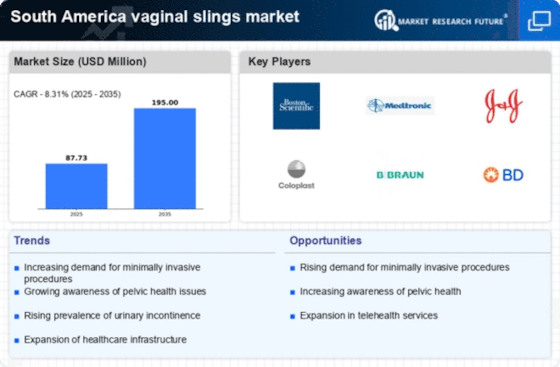Technological Innovations in Medical Devices
Technological advancements in medical devices are significantly influencing the vaginal slings market in South America. Innovations such as minimally invasive surgical techniques and the development of biocompatible materials are enhancing the effectiveness and safety of vaginal slings. For instance, the introduction of mesh slings has improved surgical outcomes, leading to higher patient satisfaction rates. The vaginal slings market is witnessing a surge in product offerings that incorporate these advanced technologies, which may lead to increased adoption rates among healthcare professionals. Additionally, the integration of robotic-assisted surgery is expected to further revolutionize the surgical landscape, potentially increasing the number of procedures performed and expanding the market.
Increasing Incidence of Pelvic Floor Disorders
The rising incidence of pelvic floor disorders in South America is a crucial driver for the vaginal slings market. Conditions such as urinary incontinence and pelvic organ prolapse are becoming more prevalent, particularly among the aging population. According to recent health statistics, approximately 30% of women over 50 experience some form of pelvic floor disorder. This growing demographic is likely to seek effective treatment options, thereby increasing the demand for vaginal slings. The vaginal slings market is poised to benefit from this trend, as healthcare providers are increasingly recommending surgical interventions to improve quality of life. Furthermore, the awareness surrounding these disorders is gradually increasing, leading to more women seeking medical advice and treatment, which could further stimulate market growth.
Rising Female Empowerment and Health Awareness
The rising trend of female empowerment and health awareness in South America is positively impacting the vaginal slings market. Women are increasingly taking charge of their health, seeking information about pelvic floor disorders, and advocating for their treatment options. This shift in mindset is likely to lead to higher consultation rates with healthcare providers, as women become more proactive in addressing their health concerns. The vaginal slings market stands to benefit from this cultural change, as more women are likely to consider surgical interventions as viable solutions. Furthermore, educational campaigns aimed at raising awareness about pelvic health are expected to contribute to increased demand for vaginal slings, as women become more informed about their treatment options.
Growing Investment in Healthcare Infrastructure
The growing investment in healthcare infrastructure across South America is a significant driver for the vaginal slings market. Governments and private entities are increasingly allocating funds to improve healthcare facilities and services, which is likely to enhance access to surgical treatments for pelvic floor disorders. For example, Brazil and Argentina have reported substantial increases in healthcare spending, with investments reaching billions of $ in recent years. This influx of capital is expected to facilitate the establishment of specialized clinics and hospitals equipped to perform vaginal sling procedures. As healthcare access improves, the vaginal slings market may experience a corresponding rise in demand for these surgical solutions, as more women seek treatment for pelvic floor disorders.
Supportive Regulatory Environment for Medical Innovations
A supportive regulatory environment for medical innovations is fostering growth in the vaginal slings market in South America. Regulatory bodies are increasingly streamlining the approval processes for new medical devices, which encourages manufacturers to introduce innovative products. This trend is particularly relevant for vaginal slings, as advancements in design and materials are being recognized and approved more rapidly. The vaginal slings market is likely to see an influx of new products that meet the evolving needs of patients and healthcare providers. Additionally, favorable regulations may enhance market competition, leading to improved product offerings and potentially lower costs for consumers, thereby stimulating market growth.


















Leave a Comment